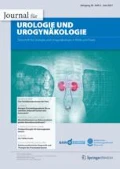Zusammenfassung
Das Fach Urologie befindet sich gesellschaftlich, gesundheitspolitisch sowie medizinisch in einem laufenden Wandel.
Infolge der demografischen Veränderungen mit einem erheblichen Anstieg an geriatrischen PatientInnen ist davon auszugehen, dass der Bedarf an urologischen Dienstleistungen in Zukunft weiter ansteigen wird.
Die Versorgungsstruktur wird weiter durch eine Forcierung ambulanter und tagesklinischer Eingriffe geprägt, wobei dies aufgrund der Besonderheiten des Fachgebietes der Urologie und der vermehrt geriatrischen Patienten ambitioniert erscheint.
Bei den Therapietechniken gewinnen (neue) minimal-invasive Verfahren an Bedeutung, wie z. B. beim benignen Prostatasyndrom. Weitere wesentliche Entwicklungsfelder sind die personalisierte Medizin bei Tumorerkrankungen sowie auf Basis der technischen Weiterentwicklung „virtual und augmented reality“.
Abstract
The field of urology is undergoing constant social, health policy and medical change.
As a result of demographic changes involving a considerable increase in geriatric patients, it can be assumed that the demand for urological services will continue to rise in the future.
The structure of care will continue to be characterized by a push for outpatient and day-clinic procedures, although this appears ambitious given the special characteristics of urology and the increased number of geriatric patients.
In terms of therapeutic techniques, (new) minimally invasive procedures, such as in benign prostate syndrome, are gaining in importance. Other important fields of development include personalized medicine for tumor diseases, as well as virtual and augmented reality based on further technical development.
Literatur
Statistik Austria (2021) Bevölkerungsprognose 2021. Erstellt am 10.11.2021
Zentralinstitut für die kassenärztliche Versorgung in Deutschland Zentralinstitut für die kassenärztliche Versorgung in Deutschland. www.zi.de. Zugegriffen: 18. Jan. 2022
Stephan-Odenthal M (2019) Einfluss des demographischen Wandels auf die Urologie. Urologe 58:54–58
Österr. Ärztekammer (2020) Ärztestatistik
Neuhauser J (2019) Studium: Mehr Frauen als Männer in der Medizin. Die Presse, Print-Ausgabe, 05.08.2019
Necknig UH, Arnold H, von Ostau N et al (2020) Urologie mit Zukunft und Familie! Urologe 59:149–152
Wishahi M, Mattigk A, Siech C, Fassbach M, Aeishen S, Bellut L, Arnold H (2020) Die Urologie wird weiblich. Urologe A 59:647–648
Marboe I (2019) Frauen in der Medizin, die Zukunft ist weiblich. Ärztemagazin, 13.05.2019
Wilson CA, Aminsharifi A, Sawczyn G, Garisto JD, Yau R, Eltemamy M, Kim S, Lenfant L, Kaouk J (2020) Outpatient extraperitoneal single-port robotic radical prostatectomy. Urology 144:142–146
Mehrazin R, Bortnick E, Say R, Winoker JS (2020) Ambulatory robotic-assisted partial nephrectomy: safety and feasibility study. Urology 143:137–141
Schöb DS, Reichelt AC, Gross AJ et al (2020) Neue operative Techniken zur Therapie des benignen Prostatasyndroms. Urologe 59:347–358
Urologie Planegg https://www.ukmp.de. Zugegriffen: 17. Jan. 2022
Sparwasser P, Haack M, Frey L et al (2021) Virtual und Augmented Reality in der Urologie. Urologe A. https://doi.org/10.1007/s00120-021-01734-y
Author information
Authors and Affiliations
Corresponding author
Ethics declarations
Interessenkonflikt
E. Heinrich und R. Larch geben an, dass kein Interessenkonflikt besteht.
Für diesen Beitrag wurden von den Autoren keine Studien an Menschen oder Tieren durchgeführt. Für die aufgeführten Studien gelten die jeweils dort angegebenen ethischen Richtlinien.
Additional information
Hinweis des Verlags
Der Verlag bleibt in Hinblick auf geografische Zuordnungen und Gebietsbezeichnungen in veröffentlichten Karten und Institutsadressen neutral.
Rights and permissions
About this article
Cite this article
Heinrich, E., Larch, R. Zukunft der Urologie. J. Urol. Urogynäkol. AT 29, 6–10 (2022). https://doi.org/10.1007/s41972-022-00154-0
Accepted:
Published:
Issue Date:
DOI: https://doi.org/10.1007/s41972-022-00154-0
Schlüsselwörter
- Demografische Entwicklung
- Ambulante Versorgung
- Minimal-invasive Therapie
- Robotische Operationen
- Erweiterte Realität

